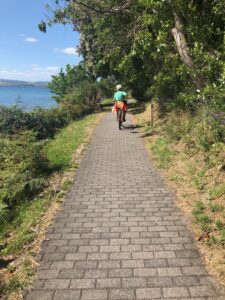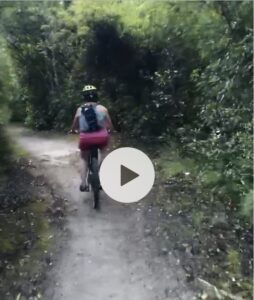Hurtling down a single track next to a river gorge is a bit more of an adrenaline rush than I need. Joyful movement to me is a mix of gently to moderately challenging my body, possibly a small amount of adrenaline. Ideally, it includes being in nature, seeing beauty, being alone or with someone with whom I share a meaningful relationship and maybe even getting enough endorphins that make me feel good afterward. 
Hopping on a rented electric mountain bike in New Zealand, it was a surprise to see that I would be on a narrow trail with deep ruts at times, a steep drop off down to a river, little rickety bridges to cross mixed with flat wider paths. Obviously I haven’t done mountain biking before…
A Mr. Toad’s wild ride mountain biking experience isn’t what I’d anticipated. Although I was proud of myself for being able to do it, this was a bit beyond the moderate exercise that I’m comfortable with and what research (thus far) shows us helps with overall health quality.
In this series on having more hope, I’m sharing some of the keys from the presentation, “Psychology of Happiness, a Provider and Patient Perspective” in September of 2019 by Dr. Ralph Carson, RD, LD, PhD and ERC National Recovery Advocate Shannon Kopp put on by EDCI & NEDN – (Nebraska ED Network) Omaha, NE.
A takeaway from their presentation is that the key of ‘joyful movement’ helps create new cells through neurogenesis in our left pre-frontal cortex (LPFC) that helps grow hope. “Research has also shown that metrics of overall health quality in humans follow a dose-dependent relationship with the duration and intensity of exercise, with the best outcomes linked to moderate exercise.” (Larson et al., 2006)
Movement that is joyful is a concept that most children have. They move their bodies because it’s fun. The fitness obsessed culture we live in has taken the joy away for so many people, especially our children with eating disorders. They’re told incessantly by the ed that they must move and burn off what they ate. We can be told by our doctors, friends, family, etc that we must keep “exercising” to stay healthy. This can sap the joy out of physical activity.
The key of moderate and joyful movement as Dr. Carson shared, helps increase our hope by growing cells in the LPFC. Whether we are a person in recovery or their family caregiver, it can help us grow our hope.
The right PFC keeps us safe, it’s where we experience anger, fear and disgust. Feeling like I might fall down a cliff into a river grew my fear…and Dr. Carson said we need a balance of the cells between right and left to get happiness.

Just a photo from a video of me on the easy part of the single track. (Don’t know how to grab a screen shot from a video yet).
Thankfully the trail was much like life…eventually it smoothed out and was easy and I felt safe again.
Exercise regulates a key molecule called BDNF, which plays a critical role in the processes in neurogenesis (creation of new cells). If you’d like to read more about BDNF – Brain-derived neurotrophic factor, click on this article here.
Hopefully I created more BDNF and therefore, new cells in my left PFC during the mountain biking adventure, I sure felt good afterward so maybe I did.
A lot of life lessons kept me moving forward and having fun rather than getting stuck in a rut of fear.
Most of the family caregivers with whom I coach have challenges with not getting stuck in a rut of fear. Metaphors are a tool we use in coaching which helps clients embrace shifting new perspectives. I experienced so many metaphors for getting through really scary, hard, rough spots and getting stuck in the ruts by my fears.
Here are the life lessons that kept me moving forward and having (mostly) fun:
- Focus on the fun not the fear.
- Trust the bike and my muscle memory (thank goodness for downhill skiing experience).
- Keep moving when things get scary, it shortens the suffering. The slower we go in the rough spots, the longer our suffering is.
- Believe in yourself. And believe in yourself succeeding.
- Change is inevitable, so when it’s hard, remind yourself it will get easier. It will also get hard again so relish the easier times…(I know easier said than done).
- Focus on the excitement; feeling terrified and excited are very similar. LOL.
- Remember you’ve done hard stuff before, you can do it again.
Believing in my capacity to do hard things was important when I was afraid I was going to fall down the side of the cliff or fall into a gully or go over the handlebars. I kept telling myself, I believe in you Becky. You can do this. The path will smooth out…and it did. I coached myself through it and saw so many metaphors for when life is hard.
The longer we stare at the hard thing and ponder how to get through it, the more we suffer. I can still see some of those deep ruts I was tempted to focus on – don’t have photos ‘cause I kept moving. 😉
Keeping moving forward and focused on the smoother parts really does help. It shortens the suffering and increases the joy. Who knows, maybe I made new cells in my left pre-frontal cortex that balanced out the new cells in the right PFC that those moments of fear created.
How do you avoid being stuck in a rut of fear?

